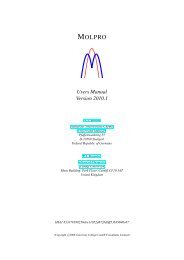CHAPTER II. POTENTIOMETRY AND REDOX TITRATIONS I ...
CHAPTER II. POTENTIOMETRY AND REDOX TITRATIONS I ...
CHAPTER II. POTENTIOMETRY AND REDOX TITRATIONS I ...
- No tags were found...
Create successful ePaper yourself
Turn your PDF publications into a flip-book with our unique Google optimized e-Paper software.
⇒ E = (0.05916/n) ⋅log(a 1 /a 2 )(n = charge of ion)ii/. Glass Electrodes for pH measurementsFIGURE 2-5. “Harris” (p. 323).FIGURE 2-6. “Harris” Fig. 15-3 (p. 316).H + + Na + Gl − = Na + + H + Gl −soln. solid soln. solidFIGURE 2-7. “Harris” Fig. 15-12 (p. 325).FIGURE 2-8. “Harris” Fig. 15-13 (p. 325).The reaction in which H + replaces metal cations in glass is an ion-exchangeequilibrium. This equilibrium constant is so large that surfaces of hydrated glassmembrane consist of entirely silicic acid (H + Gl − ).E b = E 1 − E 2 = 0.0592⋅log(a 1 /a 2 )where a 1 = activity of analyte solutiona 2 = activity of internal solutioni.e., E b = −0.0592⋅log(a 2 ) − 0.0592⋅pH = constant − 0.0592⋅pH (1)Alkaline Error: The apparent pH is lower than true pH.Some glass membranes also respond to concentration of alkaline metal ions.M + + H + Gl − = H + + M + Gl −soln. solid soln. solidwhere M + represents some singly charged cation, such as sodium ion.K ex = (a 1 b 1 ’)/(a 1 ’b 1 )where a 1 and b 1 are activities of H + and M + in solution, respectivelya 1 ’ and b 1 ’ are activities of H + and M + in gel surface, respectivelyK ex is usually small in value except when [H + ] is low and [M + ] is high.Selectivity Coefficients:The effect of an alkaline metal ion on potential across a membrane can be3











![Hetero [6+3] Cycloaddition of Fulvenes with N-Alkylidene Glycine ...](https://img.yumpu.com/35423358/1/190x245/hetero-6-3-cycloaddition-of-fulvenes-with-n-alkylidene-glycine-.jpg?quality=85)




